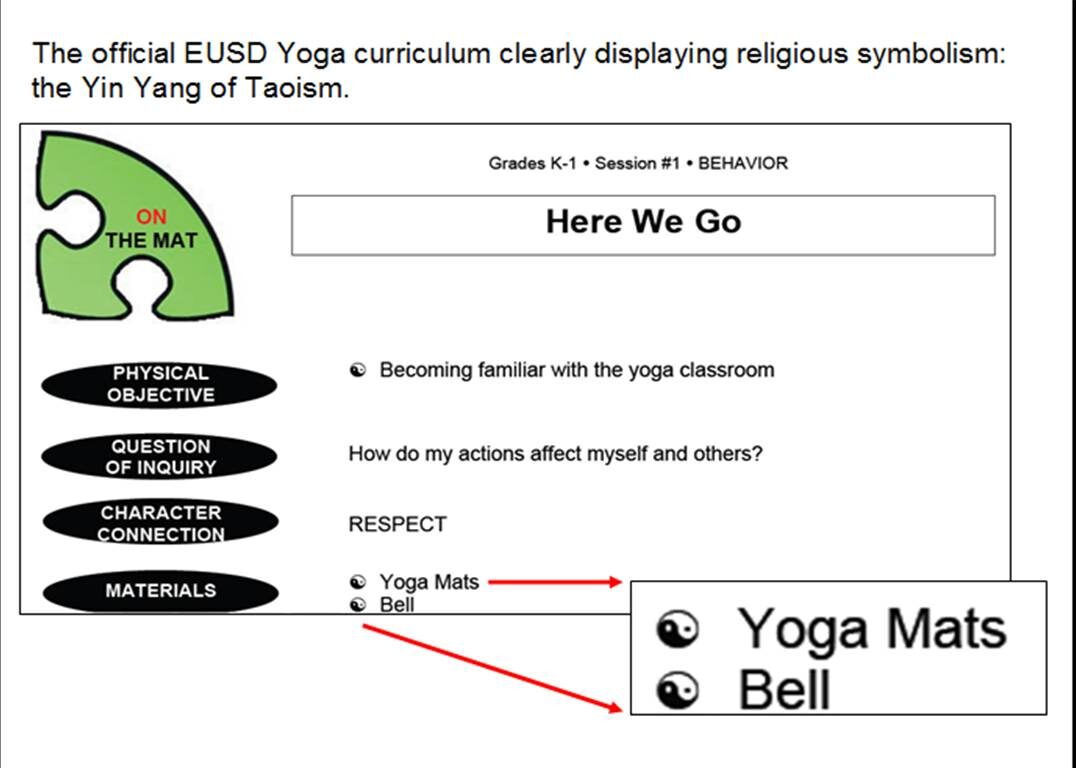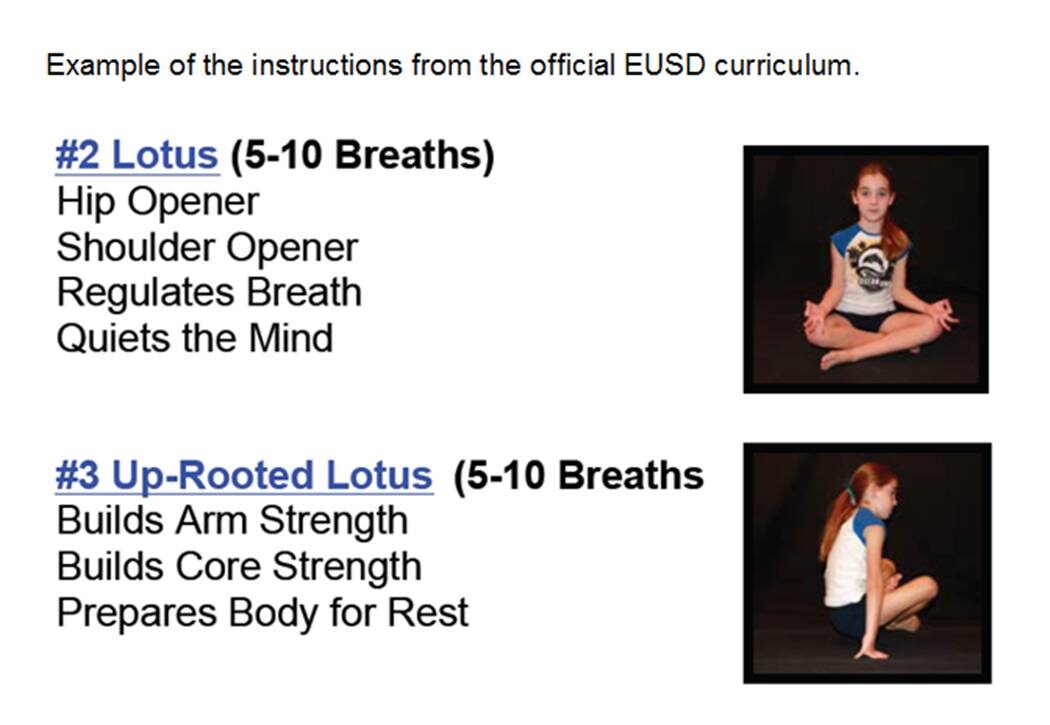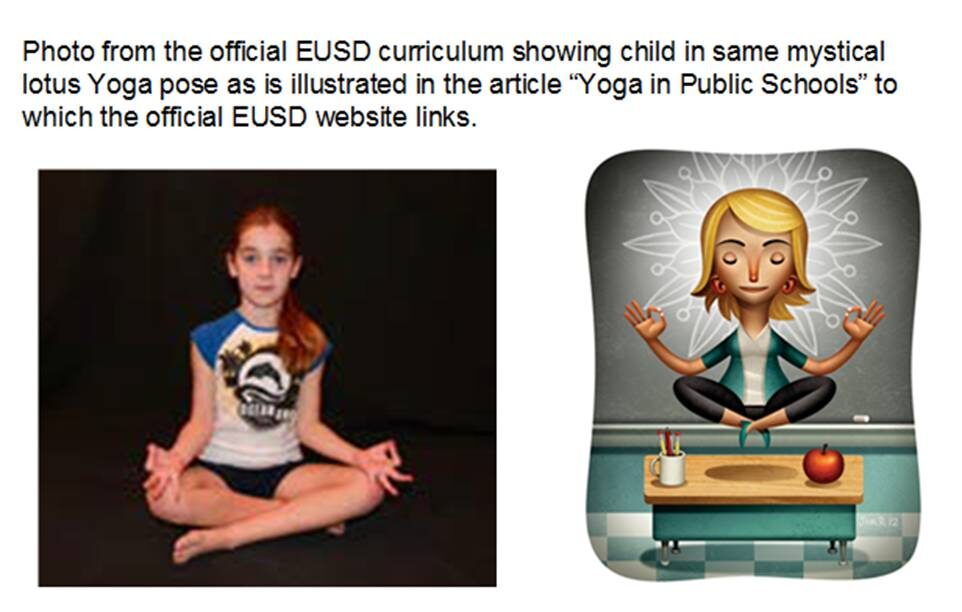We now continue, from part 1 wherein we described what Yoga is, considering the issue of Yoga in public schools. This issue has come and gone at since circa the 1960s and has arisen again via the Encinitas United School District in California (the EUSD).
On the official EUSD website Tolerance Magazine’s article Yoga in Public Schools. Instantly one gets the message as the article is accompanied by illustrations which very clearly encourage religion with tax payer funded public schools. In the attached slide show you will see that one illustration is of a teacher levitating above her desk, in the tax payer funded public school classroom, in a lotus meditative position, with hand in the gyan mudra position (which looks like an “okay” hand symbol), and eyes closed behind whom is a mandala style illustration, on the chalk board, of a flowering lotus plant.
The other illustration is of a child who is, literally, bent over backwards on the floor of the classroom (same floor as that in the teacher’s illustration) reading a book out of which is flowering the lotus plant.
But let us not judge the article and thus the EUSD upon illustrations—telling as they are—but consider the text which the tax payer funded public school district saw fit to link from their official website.
The article notes that teacher Chelsea A. Jackson:
…had been turning to yoga to help manage stress, and had found that the practice improved her fitness, attitude and self-confidence. Why couldn’t her students benefit in similar ways?
She covered her classroom window with construction paper to reduce distractions. She showed her students how to focus on their breathing. She demonstrated a few simple poses.
Good question, “Why couldn’t her students benefit in similar ways?” They could and they could do so in the very same manner as she: in their personal time off of public school grounds.
One wants to ask “Where is covering windows, focusing on breath and performing Yoga poses in the curriculum? That is most certainly a good question and yet, the problem is that we then raise the curriculum above the law, above the constitution and above ethics. This is because if it is not in the curriculum a school district could simply place it therein and the argument ends—at least on that level.
You will find that much of the push for getting Yoga into public schools is based on the ends justify the means. Simply stated it is simply asserted that if it helps students then it must be okay:
Student attention spans increased. They were resolving their own conflicts. Lessons went more smoothly…her students would request a “few minutes for breath”… And a limited—but growing—body of research indicates yoga for kids may be an effective strategy for proactively managing classroom behavior and efficiently boosting student learning and performance…
broad-based evidence of yoga’s potential benefits for students awaits research on a larger scale, limited studies and anecdotal evidence continue to convince educators to give it a chance.
Students are requesting “few minutes for breath” but what if they request “few minutes for prayer”? Then they would be told that what they are requesting is illegal and that, perhaps, they can do it as long as no one knows about it, as long as they don’t get caught. Locally a school teacher told a student that she could not say “Merry Christmas” because that was a bad thing.
Well, there are a myriad of practices that students would find beneficial (such as prayer, for which there is a tremendous amount of evidence) so why pick one that has admittedly religious roots? No separation of ashram and state apply here?
But does Yoga have religious roots? We covered this in part 1 and also the article in view elucidates this question:
Yoga’s history stretches back thousands of years, and its practice has roots in Hindu, Jain and Buddhist religious practices in India and East Asia. It has been described as a discipline for focusing and connecting mind, body and spirit, and has found adoptees among other religions as well as the non-religious. That its “adoptees” are both religions and non-religious is where they hedge their bets as they go on to note:
A secularized form that emphasizes fitness and stress-reduction is now well established in Western countries, and one can find a proliferation of yoga studios in most American cities.
Indeed, one can attend a Roman Catholic church and partake of the eucharist during the mass in the act of communion and claim that it is not religious because, “Well, I don’t believe that the bread and wine turn into the body and blood of Jesus.” One can keep kosher and claim that it is not religious because “Well, I’m not Jewish, I just find that it is a healthy diet.” Indeed, one can water down and redefine that which they will and yet, the reason for watering it down and redefining it is because of its religious premise.
In fact, Caryl Matrisciana, who was born in India and lived there for two decades, interviewed Yogis, Yoga’s gurus, who are offended that Westerners are watering down Yoga by claiming that it is not religious (see link below).
The article also notes that Susan Solvang, executive director of K–12 Yoga in Milwaukee, began a pilot program in Cass Street School wherein, “The instructors taught mindful breathing.” But why does anyone need to be taught to breath? No one does; this is about teaching how to breath or rather how to focus on breath so as to cause a meditative state whereby the mind is opened up to well, whatever is poured into it (the specific purpose was elucidated in part 1).
Perhaps the worst part of the article to which the EUSD linked is that it recommends fooling people who do not know any better by hiding the yogic nomenclature, “In some instances, instructors can address concerns by a yoga demonstration sans yogic nomenclature.” This is what Yoga instructor Tara Guber did at the Accelerated School in Los Angeles.
In the next segment we will see that the official EUSD curriculum is not so shy but actually teaches Yoga, “Using the actual names of the poses.”
Elliot Miller notes the following in his article Yoga for Kids: Yoga in Schools (an article which provides a lot of the legal battles fought over this issue):
Tara Guber, the creator of the “Yoga Ed.” program that was implemented in Aspen, simply took the overtly Hindu language out of the program while keeping everything else intact, and the strategy worked. As the Associated Press reported: Guber crafted a new curriculum that eliminated chanting and translated Sanskrit into kid-friendly English. Yogic panting became “bunny breathing,” and “meditation” became “time in.”
“I stripped every piece of anything that anyone could vaguely construe as spiritual or religious out of the program,” Guber said.
Note that she most certainly did not strip Yoga of anything that anyone could vaguely construe as spiritual or religious. What she did was to keep everything that anyone could vaguely construe as spiritual or religious but hid it behind alternative terminology.
The article notes:
…some parents who believe its roots in Eastern religions mean it should have no place in public schools.
And, of course, Tolerance Magazine could not go without singling out one, and only one specific religion as opposing that which is so very beneficial for children:
Some devout Christians fear it could lead young minds toward other religious beliefs or mysticism. A few districts have banned yoga, as well as visualization practices or meditation instruction.
Of course, the issue is that if you could prove that Yoga is utterly religious and involves all sorts of occult practices—which it does and which is very, very easy to prove—many parents would think that it was just wonderful and that of course it should be allowed in tax payer funded public schools
And another of the myriad of reasons for not having your children in public schools rears its religious head.
Here are some relevant books:
Knowing the Facts about Yoga by John Ankerberg and John Weldon
Should Christians Practice Yoga? by John Weldon
A DVD: Yoga Uncoiled From East to West by Caryl Matrisciana
For more info see the following videos:
Yoga as Christian Occult Practice by Caryl Matrisciana
The Yoga Boom: What are Christians to do? by Elliot Miller
For more background and consideration of some Hindu philosophy see the video:
Bill Honsberger – Hinduism and Advaita Vedanta: the Roots and Fruit of a Movement




